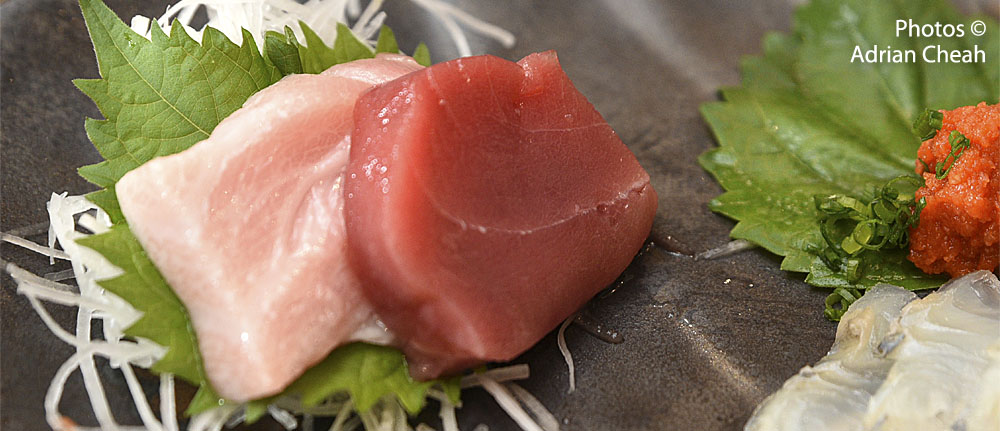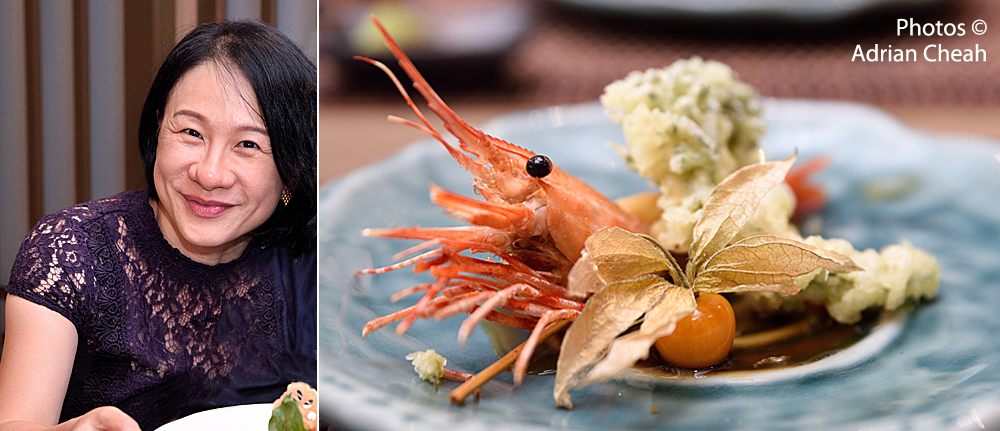Sublime omakase experience at Dozo Penang

"Omakase" is the short term used for "omakase shimasu" which means "I will leave it to you (chef)". It gives creative freedom to the chef to conjure up an unforgettable culinary experience. This style of dining is best indulged with an open mind, a willingness to try new experiences, leaving all biases aside.
The dinner we had at Dozo Penang was carefully curated by Chef Kim based on what he knew about us. After weeks of liaising, I was really looking forward to an exciting and scrumptious evening. We arrived at 6:00 pm to begin the omakase journey into the Land of the Rising Sun. Will the dishes be rooted in distinct traditional Japanese flavours or slanted towards an avant-garde flare of contemporary chic?

Upon arrival, we were ushered into a private dining room bathed with warm wood tones and on a wall, two paintings of Mount Fuji. I brought along a bottle of sake to accompany the Japanese affair. Chef Kim greeted and assured us that the dinner would be both pleasurable and titillating.


We started off the dinner with an appetizer of three offerings. Served on a white rectangle dish stood the items to be consumed from right to left. On the right were fine strands of mozuku seaweed subtly seasoned with vinegar. It had a recognisable taste of the ocean. In the middle was kaiso seaweed topped with fugu (blowfish) skin resting on a semi-circle slice of radish dyed bright green – an intriguing mix of ingredients that was perfectly matched with tosazu dressing. On the left were firefly squids heavily salted with soy sauce and sake, resting on a shiso leaf. This reminded me of garum, a potent fermented fish sauce (made from fish guts) common in ancient Greece. Sans the strong odour, the squids were an acquired taste that would be difficult for me to appreciate.

I would describe the next course as an inventive chawanmushi (egg custard) meeting a thick shark fin-like soup (dashi broth, of course, minus shark fins) topped with diced snow crab. Chef Kim explained that it was his intention to offer something light, leaving room for us to sample more creations. The silky smooth texture and combination of flavours were brilliant.

After the "soup" came a serving of three types of sashimi – five thinly sliced hirame (flounder) with a dipping sauce, a slice each of maguro akami (bluefin tuna loin) and maguro o toro (bluefin tuna belly). Served on the side was freshly grated wasabi.
The soft chewy texture of the hirame went very well with the tosazu sauce. We were provided with the option of how spicy we wanted our dipping sauce to be as the orange-coloured momiji oroshi (of grated radish) was served on the side.
Next was a slice of akami. This cut, from the centre leanest part of tuna has a bolder taste profile. Dipping it lightly in soy sauce and topping it with a little wasabi was all that was needed.
O toro, the pale fatty belly part of the tuna has to be the most excellent cut. It was so soft and creamy that it would literally melt in the mouth. My heart burst with joy and I was unable to contain the expression that I have just tasted something delightful divine.

I was surprised to learn via research online that preparing sashimi is among the most difficult skills to master in Japanese cooking. At first glance, how difficult can cutting fish flesh be? Well, truth be told, it is! Fish is soft and to slice it without damaging the flesh takes practice. Mastering the knife is also crucial. Excessive force will fracture the delicate texture of the fish. Handling the thinly-sliced hirame and the buttery-soft o toro illustrated the skilful execution of Chef Kim.

Two of my friends abstain from beef; they were served lightly grilled kinki (rockfish), a rare fish found in Hokkaido. The firm, slight pink coloured flesh had a springy texture and refined rich flavours. Although the taste was scrumptious, a larger portion would have been much appreciated as it was gone too soon.

Japanese wagyu is at the pinnacle of the steak world. The grading set by the Japan Meat Grading Association is completely universal with a score based on its yield (A-C) and level of marbling, firmness, colour and overall quality (1-5), with A5-grade being the crème de la crème of all steaks.
The steak served that evening was out-of-this-world good! The exquisitely marbled A5-grade wagyu was seared to perfection, served with a light yakiniku and red wine sauce. The sublime quality of the beef was almost ludicrous, being among the finest I have savoured. This dish made my day and was worth every cent on the bill.

The next course was a shrimp dish served with crispy broccoli tempura. Botan ebi, a Hokkaido speciality was in season. The flesh of the pandalid shrimp with a strong orange-red hue was tender and sweet, a noticeable contrast from the crispy golden breaded casing that protected it. The gooseberry was more than a mere decorative item on the plate but a necessary component to cleanse the palate as we awaited the next course.

Dating back to around the 1800s, sushi has been part of Japanese culture for centuries. Whether you eat it by hand or chopstick, always dip the fish or topping part lightly into soy sauce. This will prevent the fluffy sushi rice from falling apart! Since we were all Asians and experts at using chopsticks, we did not use our hands. (If we had done so, we would have used the available oshibori (wet towel) to wipe our hands clean.)
With the sushi, we were again recommended to start from right to left, with the delicate flavours first, working our way up to the stronger tasting toppings. To cleanse the palate and reset our taste buds, we were advised to enjoy some gari (pickled ginger) before advancing to the next piece.
The chef had carefully measured the amount of wasabi, adding it between the rice and topping. I enjoy a stronger hit so I picked up a bit of wasabi and put it directly onto the sushi. (Do not mix the wasabi with the soy sauce as one will not then be able to determine the desired amount.) Sushi is a one-bite offering, so gobble it up at one go and do not attempt to cut it up with chopsticks.

The first sushi was made with lightly charred hirame, brushed with a shoyu sauce and topped with black caviar. The saltiness of the caviar, the mild sweetness of the fish and fluffy vinegared rice danced in my mouth, joyful flavours all rolled into a mouthful. Next was a sushi with a silver-skinned fish aji (horse mackerel), topped with a little grated horseradish and onions. This had a stronger umami aftertaste. I had to reset my palate with a slice of gari before proceeding further. The third piece was with a slice of akami seasoned with shoyu. I love the tuna! By the way, the sushi rice was seasoned with akazu (red vinegar) synonymous with traditional Edomae-style sushi.

These three pieces of sushi would have tasted different if we were seated in front of the chef, made with warm rice and served immediately. By opting for a private dining room to enjoy each other's company, we had to forgo the cooking experience of seeing the chef in action from skilful blade work to dextrous hands forming the sushi. We were also unable to have an intimate conversation with the chef as he prepared the meal or watched our reactions towards the dishes he had prepared. Having said that, before the meal commenced, we had been introduced to the chef and during some courses, he was at hand to provide a brief explanation on a dish and how we should consume it. His presence was much appreciated and made a difference in our dining experience.

Next was the comforting bowl of miso soup, sweetened with short neck clams, fresh nori (seaweed) and mushrooms.

To conclude the meal, an opulent ocha-flavoured mousse topped with edible gold leaf was presented. Chef Kim whipped it up by hand, adding extra care in making the dessert. The slight bitterness from the fragrant green tea perfectly balanced the rich creamy mousse. For texture, a few little chocolate flakes were added alongside a contrasting red strawberry. It was the perfect note to complete a stupendous culinary opus.
The four-hour dining experience flew by unduly fast as we had such an enjoyable evening. Such memorable moments should not be hurried; they enable us to appreciate each other's company as we explore exquisite cuisine presented before us, visually appealing and spellbindingly enchanting in flavours.
My experience with the omakase multi-course meal at Dozo Penang was certainly transformative and it will be for you as well.
---------------------------------------------------------
Written and photographed by Adrian Cheah
© All rights reserved
12 October 2020
---------------------------------------------------------
Dozo, Penang
No. 1-1-26, 27 & 28 (Ground Floor), SummerSkye Square, Jalan Sungai Tiram 8, 11900 Bayan Lepas, Penang.
T: +604 608 6296
Opens: 11:30 am – 2:30 pm, 5:30 pm – 10:00 pm (Monday – Thursday) | 11:30 am – 10:00 pm (Friday – Sunday)
Since omakase is so dependent on the happiness of the guest, it is not uncommon to find that one would have the chef's full attention. At Dozo Penang, only a minimum of two to a maximum of 10 guests is required for reservations made at least one or two weeks in advance. This is necessary as most of the ingredients are shipped from Japan and available only from Monday to Thursday as the restaurant is too busy on weekends.